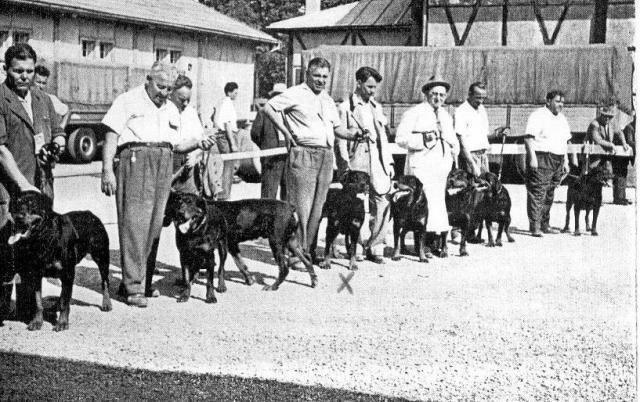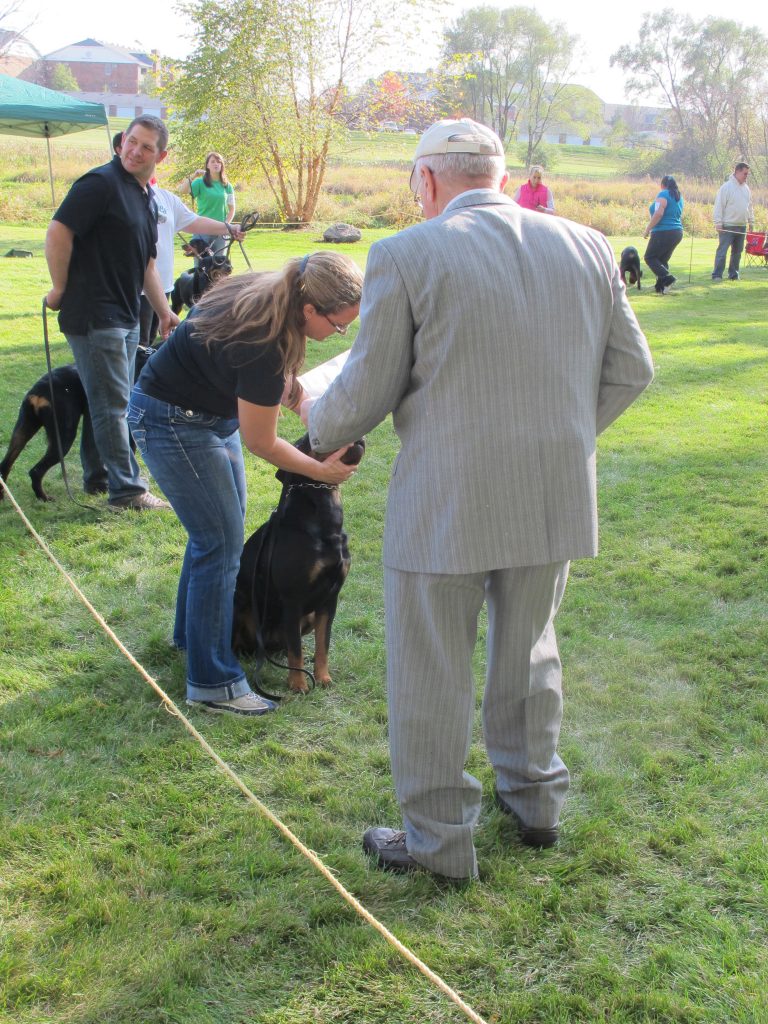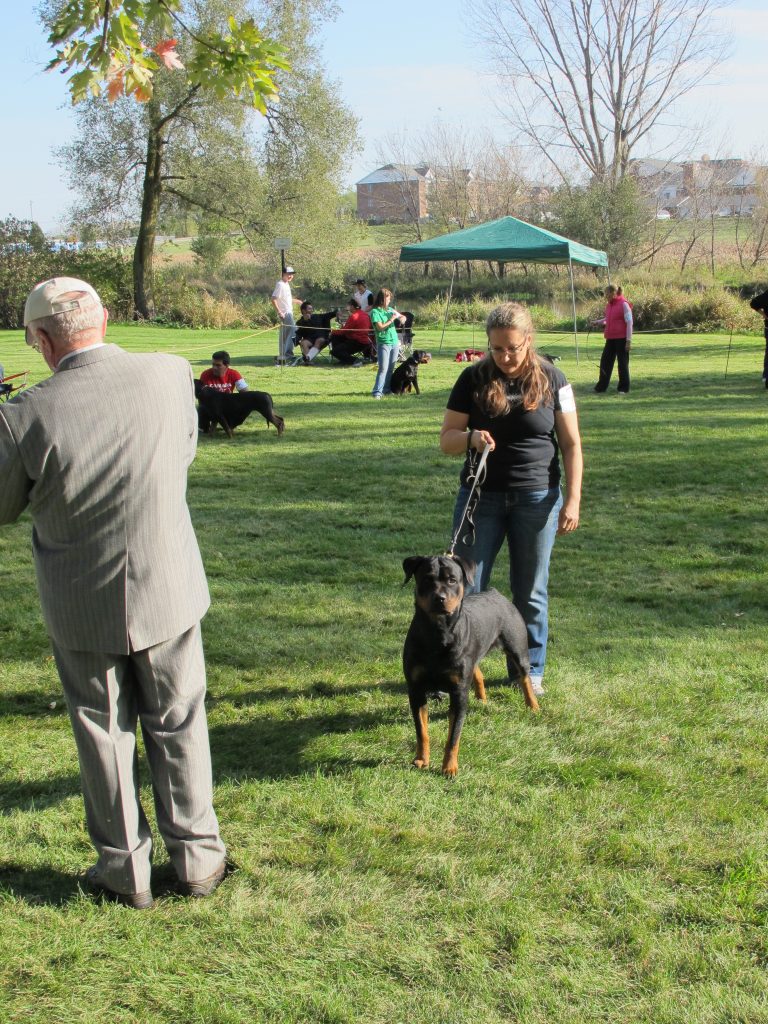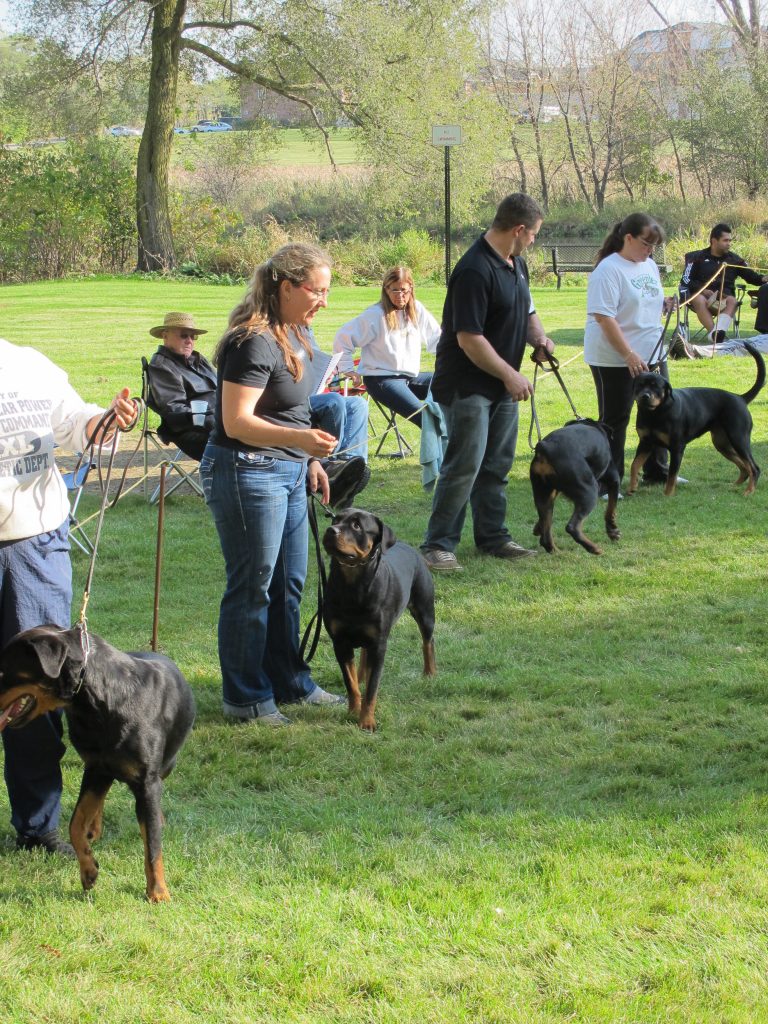What is a Sieger show?

ADRK Sieger Show - Germany 1959
The Sieger show is essentially a European or German style conformation show with the purpose of highlighting the performance aspect of the Rottweiler. The dogs are exhibited in a natural state, no hand-stacking is permitted as is seen in the AKC show ring. Dogs are baited with toys from outside of the ring by a second handler. The show also allows both docked and natural tailed Rottweilers to compete. The Sieger Show is a special event using a different judging style where each dog is individually critiqued aloud by the judge and given a rating in regards to how the dog conforms to the breed standard with the judge's critique is recorded in writing and given to the exhibitor. Handlers can be changed as often as needed. When the judge is satisfied that they have been able to evaluate all the dogs in the ring against each other, the judge will award placements. The event is family oriented and owners are encouraged to handle their own dogs in the ring.
The MRC has held Sieger shows in the past, with the last show being held in the year 2000, 17 years ago. The judge was FCI Judge Dr. Carla Lensi. After the judging, the MRC hosted a barbecue dinner and a seminar on breed type and correct Rottweiler movement conducted by Dr. Lensi.
It's Show day
The sieger show is intended to be a relaxing and fun day for dogs and handlers/owners. The show is run very similar to an AKC show. The day starts with the handler checking in at the show secretaries tent and receiving an armband and schedule of events. The classes start with male puppies first then the girls. As the day goes on, the classes progress until all dogs have been shown in their classes. When all classes are complete, the the final titles and trophies are awarded to the top dogs.
When a class is called, the handlers enter the ring and the judge may ask them to be in number order. Once lined up, then its time to relax! The judge goes to each dog and handler and assesses the dog. The handler will first greet the judge and allow the judge to see the dog. Then the handler will show the dog's teeth so that the judge can ensure the dog has a correct bite and isn't missing teeth. Then the judge will look the dog over carefully and will verbally appraise the dog.
The judge carefully assesses the dog against the Rottweiler Standard while the handler holds the dog. The handler allows the dog to stand naturally. Though food is not allowed in the ring, a handler may use a small toy to get the dog's attention. A second handler can also be used to 'bait' the dog from outside the ring. Most shows will have an area designated for second handlers to be able to stand in front of the dog just outside the ring, while it is being judged.

The handler is showing the dog's teeth to the judge

After the initial examination for dentition and disqualifying faults, a verbal critique is conducted on each class entry and recorded verbatim on the critique form. Positive aspects as well as any faults or deviations from the standard are noted on the critique, such as any missing teeth, pink gums, light eyes, etc

Handlers and dogs standing in line and waiting to be judged.
Sieger Show details
A Sieger Show is similar to an AKC conformation show in that it has classes for gender and age groups.
Classes
For all classes the age of a dog is calculated based on the birth date and the day of the class. For example, a dog born on January 1st is eligible to compete in the 4 to under 6 Months class on April 1st; 6 to under 9 Months class on July 1st, etc.
Regardless of titles, if dog is not yet 24 months old, he must enter the age appropriate Puppy or Youth Class
Puppy Classes, Dog/Bitch:
4 to under 6 Months Rottweilers must be at least 4 months, but not yet 6 months.
6 to under 9 Months Rottweilers must be at least 6 months, but not yet 9 months.
9 to under 12 Months Rottweilers must be at least 9 months, but not yet 12 months.
Youth Classes, Dog/Bitch:
12 to under 18 Months Rottweilers must be at least 12 months, but not yet 18 months.
18 to under 24 Months Rottweilers must be at least 18 months, but not yet 24 months.
Adult Classes, Dog/Bitch 24 Months or older.
Open - Rottweilers that have not yet earned a Championship or Gebrauchshunde Title. A dog eligible to enter the Working Class and/or the North American Independent Sieger Class may choose to enter the Open Class; however, a dog with a Championship or Gebrauchshunde Title may not. If at the time of a show entry the dog’s HD/ED rating is not provided, then the HD/ED field will state “no listing”.
Champion *- Rottweilers that have earned a Championship title. This includes American Kennel Club, Canadian Kennel Club, and FCI International Champions of record, as well as any champion of record from a country that’s Championship was awarded by an FCI recognized kennel club. Select or Sieger awards are not titles. Once a dog has a Championship title, he may not enter the Open Class. However, he may choose to enter any other class that his titles and eligibility allows. If at the time of a show entry the dog’s HD/ED rating is not provided, then the HD/ED field will state “no listing”.
Working * - Rottweilers that have earned a minimum of one of the following American Kennel Club or Canadian Kennel Club titles: Companion Dog (CD); Herding Started (HS); Novice Agility (NA); Rally Novice (RN); Tracking Dog (TD). An ARC Carting Started Title (CS) would also meet eligibility requirement. A dog is also eligible if he has earned a Traffic Sure Companion Dog (BH) from DVG, WD, SV, USA, USRC, and other recognized Schutzhund organization. CGC, TT (ATTS), TDI type certifications are not eligible for entry. Dogs that are eligible for this class may choose to enter another class that his titles and eligibility allows instead. If at the time of a show entry the dog’s HD/ED rating is not provided, then the HD/ED field will state “no listing”.
Gebrauchshunde * - Rottweilers that have earned a SchH I, IPO I, VPG I, or foreign country equivalent. Dogs that are eligible for this class may not enter the Working class, but may choose to enter any other class that his titles and eligibility allows instead. If at the time of a show entry the dog’s HD/ED rating is not provided, then the HD/ED field will state “no listing”.
North American Independent Sieger * - Rottweilers with a National or Regional Sieger title from an ARC, USRC, ARV, AIRK, NIRK, Canadian Independent or another Independent Rottweiler Club show in North America. Dogs that are eligible for the Championship class or have a Youth Sieger Title are not eligible for this class. Dogs with a Sieger title may choose to enter any other class that his titles and eligibility allows instead. If at the time of a show entry the dog’s HD/ED rating is not provided, then the HD/ED field will state “no listing”.
Veteran (Junior) - Rottweilers must be at least 7 years, but not yet 9 years. A dog is eligible to enter this class regardless of what titles he has earned or what other classes he may be eligible for. Neutered dogs and spayed bitches may be entered in this class. The Junior Veteran Dog and Bitch winners are eligible to compete for Sieger/Siegerin. If at the time of a show entry the dog’s HD/ED rating is not provided, then the HD/ED field will state “no listing”.
Veteran (Senior) - Rottweilers 9 years & older. A dog is eligible to enter this class regardless of what titles he has earned or what other classes he may be eligible for. Neutered dogs and spayed bitches may be entered in this class. The Senior Veteran Dog and Bitch winners are eligible to compete for Sieger/Siegerin. If at the time of a show entry the dog’s HD/ED rating is not provided, then the HD/ED field will state “no listing”.
* Copies of title documentation must be included with entry.
Junior Handlers (JH) - The purpose of this class is to educate and give the young people of our sport a chance to learn more about their dogs and to practice and see their handling skills in a new and exciting venue and point of view. Judging is on the presentation and basic age appropriate knowledge of the breed, the quality of the dog is not decisive.
JH will compete in two age categories and must compete in the class category based on the junior’s age on the day of the show.
- Young Junior Handler Class: 10 to under 14 years.
- Youth Junior Handler Class: 14 to under 17 years.
The dog of the JH need not be entered to exhibit in the show however it be must registered by the AKC or FCI recognized country kennel club and not younger than 12 months old.
There will be one first place winner awarded in each age division. The two winners will not compete against each other.
Juniors in the class will receive a critique on their handling ability and award of participation.
Points the JH Judge will consider:
- Good contact and relationship with the dog.
- Attention to Judge’s directions.
- Showing the dog’s teeth.
- Use of ring and good tempo and control when moving dog.
- Offering a comprehensive view of the dog to the Judge (don’t stand between dog and Judge).
- Ability to handle possible problems with the dog in a show ring environment.
- Sportsmanship toward the other exhibitors and spectators.
Ratings
The Rating is how the dog compares to the breed standard. The Placement (1-4) is how the dog compares to the others in his particular class – for example V1, V2, V3 ratings would equate to a 1st, 2nd, 3rd place in the AKC ring.
- Puppy Classes Dog/Bitch, Ages 4 to under 12 Months
VP Very promising
P Promising
S Satisfactory
U Unsatisfactory
- Youth Classes Dog/Bitch, Ages 12 to under 24 Months
V Excellent (possible at judge’s discretion)
SG Very good
G Good
S Satisfactory
U Unsatisfactory
- All Adult Classes, Age 24 Months and Older
V Excellent
SG Very good
G Good
S Satisfactory
U Unsatisfactory
Ring Procedure & Guidelines
1. The ring steward will call all entries to the class. Two ring stewards are recommended. Absentees are marked in the catalog. The ring stewards and show secretary will keep a marked catalog or Judges Check–In Sheet.
2. All exhibits are presented in a natural stance; no hand stacking is permissible in any class.
3. “Free stacking” may be used to present the dog using a small toy or ball.
4. Food may not be used for baiting the dog and is not allowed either inside or outside the ring.
5. After the initial examination for dentition and disqualifying faults, a verbal critique is conducted on each class entry and recorded verbatim on the critique form. Positive aspects as well as any faults or deviations from the standard are noted on the critique, such as any missing teeth, pink gums, light eyes, etc.
6. For Rottweilers born in countries where docking is forbidden by law or where a breeder has chosen not to dock; the tail must be left in its natural condition. Dogs whose tails are left undocked may only be docked as a result of a medical necessity.
7. The tail on natural-tailed dogs will be critiqued using the FCI Standard for the Rottweiler.
8. There will be no judging preference between docked and natural tailed dogs.
9. Once all exhibits are critiqued, the judge will gait each class for ratings and placements.
